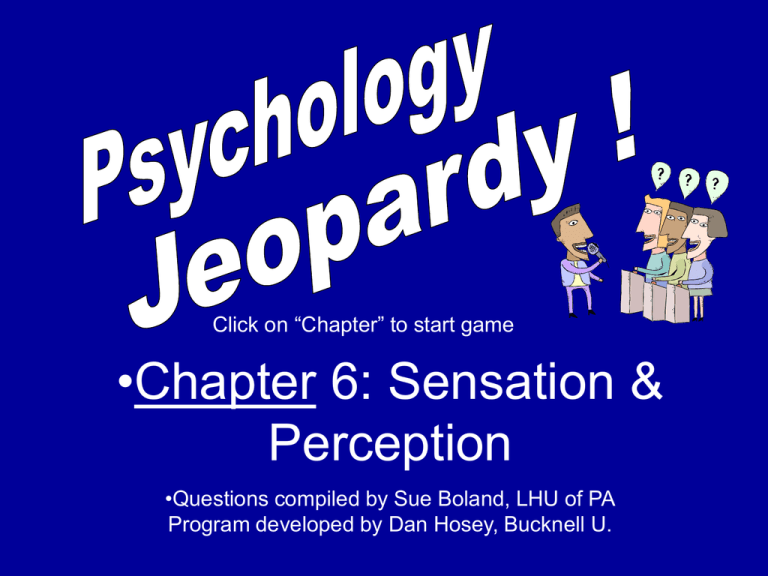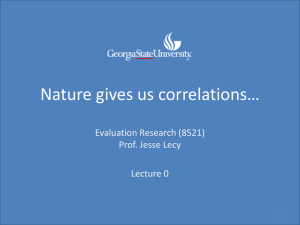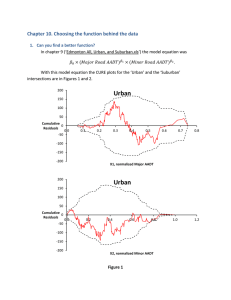•Chapter Perception
advertisement

Click on “Chapter” to start game •Chapter 6: Sensation & Perception •Questions compiled by Sue Boland, LHU of PA Program developed by Dan Hosey, Bucknell U. Common sense? Sense detectives Measure by Measure 100 100 200 The eyes have it Turn on the lights 100 100 100 200 200 200 200 300 300 300 300 300 400 400 400 400 400 500 500 500 500 500 To Round Two! C1 - 100 100 It’s the detection of physical energy emitted or reflected by physical objects. Back to board Correct Answer C1 - 200 200 You and a friend see some hovering shapes in the sky. You say they are weather balloons, your friend says they are flying saucers. The two of you share a sensation, but differ in this. Back to board Correct Answer C1 - 300 300 A category of body organs that contain cells that detect physical energy. Back to board Correct Answer C1 - 400 400 The reason why a dog can hear a “silent” dog whistle than a human can’t. Back to board Correct Answer C1 -500 500 A rare condition in which a stimulation of one sense causes a sensation in another. For example, a person may a smell the color purple. Back to board Correct Answer C2 - 100 100 Cells that detect physical energy. Back to board Correct Answer C2 - 200 200 Part of our anatomy that contains light receptors. Back to board Correct Answer C2 - 300 300 Type of sensory code base on pattern of cells firing (sending nerve impulses). Back to board Correct Answer C2 - 400 400 Most people can’t see a light shown in their ear according to this doctrine. Back to board Correct Answer C2 -500 500 The type of code our sensory systems use according to the doctrine of specific nerve energies Back to board Correct Answer C3 -100 100 Smallest amount of energy a person can detect reliably. Back to board Correct Answer C3 -200 200 Smallest difference between two stimuli that can be detected reliably. Back to board Correct Answer C3 -300 300 The percent of time a person can detect a stimulus if detection is “reliable”. Back to board Correct Answer C3 -400 400 Type of people who are likely to report that they detect a stimulus even if they aren’t sure. Back to board Correct Answer C3 -500 500 Theory that says that sense detection varies depending on a persons’ decision, alertness, motivation. Back to board Correct Answer C4 -100 100 The part of the eye that focuses objects on the retina. Back to board Correct Answer C4 -200 200 A clear covering that protects the eye. Back to board Correct Answer C4 -300 300 When my driver’s license says my eyes are brown, it is referring to this part of the eye. Back to board Correct Answer C4 -400 400 If the sun is too bright, this part of the eye will constrict to let in less light. It looks like a black dot in the middle of your eye. Back to board Correct Answer C4 -500 500 It’s where the optic nerve leaves the eye. You can’t see an image if it is projected here. Back to board Correct Answer C5 -100 100 Hue is another name for this psychological property of light. Back to board Correct Answer C5 -200 200 An index of how intense a light is. Back to board Correct Answer C5 -300 300 The small fraction of the electromagnetic energy that humans can detect with their eyes. Back to board Correct Answer C5 -400 400 Long light wavelengths are perceived as this color. Back to board Correct Answer C5 -500 500 Term for whether a light is make up of a single wavelength (pure) or multiple wavelengths (complex). Back to board Correct Answer DAILY DOUBLE Question Inside the eye Color & Form Deep, constant, illusions Powers of perception Extrasensory power 200 200 200 200 200 400 400 400 400 400 600 600 600 600 600 800 800 800 800 800 1000 1000 1000 1000 1000 To Round One To Final Jeopardy! C6 -200 200 Interior lining of the back of the eye. Contains light receptors. Correct Answer Back to Board C6 -400 400 Without these light receptors you’d see the world in black and white. Correct Answer Back to Board C6 -600 600 Very sensitive to light, these receptors help you find your seat in a dim movie theatre. Correct Answer Back to Board C6 -800 800 Located at the center of the retina, it is the spot with the heaviest concentration of cones. Correct Answer Back to Board C6 -1000 1000 The axons of these cells gang up to form the optic nerve. Correct Answer Back to Board C7 -200 200 The theory that there are three types of cones in the retina that are sensitive to different wavelengths of light. Correct Answer Back to Board C7 -400 400 We don’t see reddish green because cells that detect red and green are antagonistic according to this theory. Correct Answer Back to Board C7 -600 600 The principle that things that are alike tend to be seen as going together. Correct Answer Back to Board C7 -800 800 The German word for form. A group of psychologists who studied form perception used it as their label. Correct Answer Back to Board C7 -1000 1000 These cells in the visual cortex are sensitive to very specific aspects of a visual stimulus Correct Answer Back to Board C8 -200 200 You only need one good eye to use this type of depth cue. Correct Answer Back to Board C8 -400 400 Although a partially open door projects a trapezoidal image on your retina, you will tend to say the door is a rectangle because of this psychological phenomenon. Correct Answer Back to Board C8 -600 600 The fact that one eye doesn’t see exactly what the other eye sees is the basis for this depth cue. Correct Answer Back to Board C8 -800 800 A systematic error in perception. Back to Board Correct Answer C8 -1000 1000 It’s the depth cue that describes why in this picture you conclude that person “A” is closer to you because she is partially obscuring your view of person “B”. B A Back to Board Correct Answer C9 -200 200 An apparatus used to test whether or not babies have depth perception. Correct Answer Back to Board C9 -400 400 Even an infant can tell a sweet taste from a salty taste because some sense abilities are this. Back to Board Correct Answer C9 -600 600 A certain time window during development during which an organism must have certain experiences in order to develop normal perception. Correct Answer Back to Board C9 -800 800 An illustration of this influence on perception is that a hungry person will respond more quickly than others to food related words that are flashed on a computer screen. Correct Answer Back to Board C9 -1000 1000 It may explain why many people won’t notice that this this sentence has repeated a word. Correct Answer Back to Board C10 -200 200 It’s not a type of sandwich. It’s the name for detection of a stimulus that is below one’s absolute threshold. Correct Answer Back to Board C10 -400 400 The branch of psychology that studies extrasensory perception. Correct Answer Back to Board C10 -600 600 It’s your textbook’s answer to whether or not you should invest in a set of tapes that promises to improve your memory by playing them while you sleep. Correct Answer Back to Board C10 -800 800 The term for the ability to directly communicate with another person via the mind alone. Correct Answer Back to Board C10 -1000 1000 It’s the reason scientists had doubts about a Russian girl’s ability to see colors and objects while she is blindfolded. Correct Answer Back to Board DAILY DOUBLE Question DAILY DOUBLE Question FINAL JEOPARDY CATEGORY Sensational Senses When a stimulus is unchanging, our neurons fire less frequently, and we stop responding to the stimulus. Correct Answer C1 - 100 100 What is: Sensation? Back to board C1 - 200 200 What is: Perception? (Perception is the process of interpreting sensations and giving them meaning. So even though you and your friend are “seeing” the same stimulus, your interpretations are different.) Back to board C1 - 300 300 What is: Sense organs? (Examples include the eyes, ears, tongue, skin, nose.) Back to board C1 - 400 400 What are: Absolute thresholds vary? (Dogs have sound receptors that can pick up higher frequency sounds than do humans. This means that dogs have a lower absolute threshold for sound than do humans. That is, dogs’ sound receptors are more sensitive. Give yourself credit for any related explanation. ) Back to board C1 -500 500 What are: Synesthesia? (Apparently this is due to some people have an atypically large number of connections between brain areas that process different senses. Imagine feeling a sound, or tasting a picture!) Back to board C2 - 100 100 What is: Sense receptors? Back to board C2 - 200 200 What is: The EYE? (More specifically it is the inside lining of the back of the eye, called the retina, that contains the light receptors.) Back to board C2 - 300 300 What is: Functional code Back to board C2 - 400 400 What is: Doctrine of specific nerve energies? (Detection of a stimulus depends on the part of the anatomy that is stimulated. The ear does not have sense receptors for light, hence we cannot hear a light.) Back to board C2 -500 500 What is: Anatomical code? (If a certain part of the anatomy is stimulated (e.g., eyes) then we will detect stimulus (e.g., see light) and a specific part of the brain (e.g. visual cortex) will interpret the stimulation. If our ears were stimulated we would hear a sound and the auditory cortex would interpret it.) Back to board C3 -100 100 What is: Absolute threshold? Back to board C3 -200 200 What are: Difference threshold? (also called “just noticeable difference” or jnd) Back to board C3 -300 300 What is: 50% ? Back to board C3 -400 400 What is: Yea-sayers (Some people show the opposite decision bias and tend to say they don’t detect a stimulus when they aren’t sure. These people are call nay-sayers.) Back to board C3 -500 500 What is: Signal detection theory? (According to this theory, when we try to measure the sensitivity of human senses we are not only measuring the ability to detect a sense. We are also measuring a person’s decision about whether or not they think they detected a stimulus.) Back to board C4 -100 100 What is: The lens? Back to board C4 -200 200 What is: The cornea? Back to board C4 -300 300 What is: The iris? Back to board C4 -400 400 What are: The pupil? (The iris controls the size of the pupil.) Back to board C4 -500 500 What is a: Blind spot? (There are no light receptors (cones or rods) at this location.) Back to board C5 -100 100 What is: Color? Back to board C5 -200 200 What is: brightness? (Related to the amplitude or height of a wave of light. Taller waves are perceived as brighter or more intense. ) Back to board C5 -300 300 What is: The visible light spectrum? Back to board C5 -400 400 What is: Reds? (or oranges. Medium length wavelengths are seen as greens, short wavelengths as blues.) Back to board C5 -500 500 What is: Saturation? (A pure light consisting of a single wavelength will be seen as a highly saturated color (e.g. deep red) A light that is more complex and has multiple wavelengths will be seen as less saturated, (e.g., pink)). Back to board C6 -200 200 What is: Retina? Back to Board C6 -400 400 What is: cones? (These light receptors allow for the perception of color. It’s more accurate to say you’d see the world not only in black and white, but also as a series of grays. ) Back to Board C6 -600 600 What is: rods? Back to Board C6 -800 800 What is: fovea? Back to Board C6 -1000 1000 Who is: Ganglion cells? Back to Board C7 -200 200 What is: Trichromatic color theory? (red – long wavelengths, green – medium wavelengths, blue – short wavelengths) Back to Board C7 -400 400 What is: Opponent process theory? (When pairs of cells are antagonistic or opponents, when one cell is firing, the other one cannot fire. Thus if the cell sensitive to red is firing, the green cell cannot fire – so we can’t perceive a reddish green.) Back to Board C7 -600 600 What is: Similarity? X 0 X X 0 X X 0 X For example, most people describe the array at the left as a column Xs, column of 0s, column of Xs. That is, tend to see similar objects as grouped. Back to Board C7 -800 800 What is: Gestalt? (The Gestalt psychologists studied form and shape perception.) Back to Board C7 -1000 1000 Feature detectors? (For example, some cells in the visual cortex only respond or fire when a horizontal line is part of the visual stimulus. Some cells only respond to vertical lines.) Back to Board C8 -200 200 What is: Monocular? Back to Board C8 -400 400 What is: Shape constancy? Back to Board C8 -600 600 What is: Retinal disparity? Back to Board C8 -800 800 What is: illusion Back to Board C8 -1000 1000 What is: interposition? Back to Board C9 -200 200 What is: The visual cliff? Back to Board C9 -400 400 What is: Inborn or innate? Back to Board C9 -600 600 What is: Critical period? (For example, if a person is born blind and his or her sight is corrected during about the first nine months of life, that person is likely to develop normal sight. If the cause of the blindness is corrected later, however, when the person is older, he or she may recover some abilities, but probably won’t see normally.) Back to Board C9 -800 800 What is: Needs? (When we want something, or need something we are especially quick to perceive it.) Back to Board C9 -1000 1000 What is : Perceptual set? (Our perceptions can be affected by our expectations and by our habitual ways of perceiving. We expect sentences not to have repeated words, so we may overlook them when they appear. ) Back to Board C10 -200 200 What is: subliminal? (There is evidence that simple visual stimuli that you are exposed to so briefly that you aren’t aware of it, can affect your behavior. There is not support for the idea that more complex information is effective if presented at a subliminal level. ) Back to Board C10 -400 400 What are: Parapsychology? (Some research by parapsychologists has been criticized for not being well designed and not properly testing ESP claims.) Back to Board C10 -600 600 What is: NO? (There is no evidence that such tapes work.) Back to Board C10 -800 800 What is: Telepathy? (This is a form of ESP or extrasensory perception. There is no reliable evidence that any person has this ability.) Back to Board C10 -1000 1000 What is: She was peeking? (For example, she could only identify objects that were held low – where she could see them if she was peeking from under the blindfold. Her tricks only worked when she wore the blindfold her “teacher” gave her.) Back to Board Final Jeopardy What is Sensory adaptation? (For example, you may get used to the smell of the fish you had for dinner and no longer notice it.)







